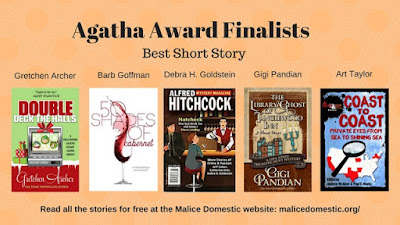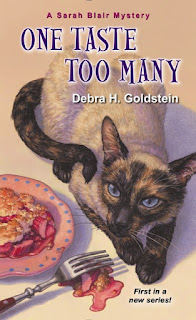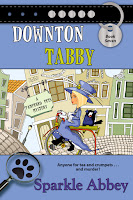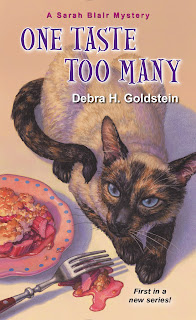Interview with Agatha Nominees for Best Short Story!
Each year, I feel very privileged to be able to host interviews with the Agatha nominees for best short story in The Stiletto Gang and Writers Who Kill. I always learn from their answers and appreciate so much what goes into the craft.
Following is a list of the nominated stories with links on the titles so you can read and enjoy. Thanks to Gretchen, Barb, Debra, Gigi, and Art for taking the time to answer the questions. And check in at Writers Who Kill tomorrow to hear more from these talented authors. Best wishes to all. — PGB
“Double Deck the
Halls” by Gretchen Archer (Henery Press)
“Whose Wine is it Anyway” by Barb Goffman in 50 Shades of
Cabernet (Koehler Books)
“The Night They Burned Miss Dixie’s Place” by Debra
Goldstein in Alfred Hitchcock’s Mystery Magazine (May/June 2017)
“The Library Ghost of Tanglewood Inn” by Gigi Pandian
(Henery Press)
“A Necessary Ingredient” by Art Taylor in Coast to
Coast: Private Eyes from Sea to Shining Seat (Down & Out Books)
are there—story arc, strong characters, interesting setting, and a puzzle to
solve—I find the idea worthy. There are many colorful characters in the Davis
Way series, so I had a surfeit of choices for a protagonist in Double Deck the
Halls. From my character list, I chose Granny. The setting is always the
same—the Bellissimo Resort and Casino in Biloxi, Mississippi. And the puzzle?
What could be more fun than an octogenarian MacGyver?
Barb Goffman: When considering if an idea is better suited to be
developed into a short story or a novel, I think the key is how complicated the
plot is and how early you want to bring your main character in on the action.
If your story involves multiple murders, for instance, and you want to show
that your protagonist is on the case from the beginning, then you’re likely
describing a novel. That idea seems too complicated to develop properly in a
short story. But if you have the same scenario and your protagonist comes in at
the last murder and quickly figures out whodunit, then that could be a short
story. Which way to go? I think that’s a style decision for the author.
This is why
I tell people that a short story is about one thing. One specific tight tale.
The more complicated the idea, the more detail you need to show, the more pages
your tale will take. The plot of my story “Whose Wine Is It Anyway?”
has two inciting incidents– twice within a few days my main character, a legal
secretary, feels slighted by her long-time boss–and the resolution comes
quickly thereafter, so it was well suited for a short story. (For those who
haven’t read the story, in Myra’s last week before retirement, she learns her
boss has hired an airhead to replace her and he does something that makes her
realize he’s been taking her for granted. So Myra devises a plan to teach him a
lesson.)
Debra Goldstein: I don’t initially
know if an idea is “short story worthy.” When a story works, it flows and ends
exactly where it should. The idea of the story may come from a prompt, a phrase
stuck in my mind, or a character’s voice. In “The Night They Burned Ms. Dixie’s
Place,” the opening sentence “I remember
the night they burned Ms. Dixie’s Place” was the first thing I thought of, but
then I realized that most of the story had to be told on that night, when the
main character was only nine years old. Once I recognized the voice would be a
child’s, the importance of the premise became evident. I write both novels and
short stories, but there was no question that this idea and the portrayed characters
and incident would only work as a tightly written short story.
Gigi Pandian: I love short
stories that have a satisfying twist. In my own short fiction, the twists that
I like to play with are seemingly impossible crimes that have a rational
explanation.
My full-length novels are adventures in addition
to being mysteries, so while my books do have twists in them, the twists and
the puzzle aren’t necessarily as important to keep the story going as the
characters themselves and the adventures they’re having.
Therefore when I come up with an idea for a
story involving an impossible crime twist, instead of an idea that centers
around a specific character or a larger plot, then I know it’s a short story
rather than a novel.
Art Taylor: I’m primarily a
short story writer, so most of my ideas seem suited to that length—it just
seems to be the form I’m most naturally drawn toward, the one I’m most
comfortable in. Ideas come from a variety of places, of course: a bit of
overheard conversation, a dream, a trip (the travel kind, not the
hallucinogenic kind!), even other short stories or novels that prompt the
imagination along. While I tend to think in narrative arcs at short story
length, I also try to fold in other threads as well to help enrich the story’s
texture and its breadth—by which I mean balancing several characters’ narrative
arc and the ways they intertwine, for example, or by layering in some thematic
arc alongside the arc of the plot, letting several things speak one to another.
I may not be able to write long very often, but I try to write dense at
least—dense in a good way, I hope!
short story and how the story came to be published.
“Double
Deck the Halls: is a short-story companion to my Davis Way Crime Caper mystery
series published by Henery Press. I knew where Deck would land before I wrote
it.
Barb Goffman: “Whose Wine Is It Anyway?” appeared in the
anthology 50 Shades of Cabernet,
which was published by Koehler Books. This book is the brainchild of author
Teresa Inge. She came up with the idea of a lighthearted anthology involving
mystery and wine. She wanted to help promote the Virginia wine industry. So she
reached out to a bunch of Virginia authors and asked if we’d be interested in
submitting stories for the book. After doing a lot of interesting research I
came up with a workable story idea, wrote my story, and submitted it. Teresa
shopped the manuscript around and Koehler ended up picking it up. They’re based
in Virginia Beach, near where Teresa lives, so it all worked out very nicely.
Koehler gave us multiple rounds of edits and proofreading. And royalties.
What’s fun about them is for each book they publish, they put two potential
covers on their website and the general public can vote on which one they like
better. The cover with the most votes becomes the cover of the book.
Debra Goldstein: Alfred Hitchcock Mystery Magazine not only published my first submission to it, “The
Night They Burned Ms. Dixie’s Place,”
in its May/June 2017 issue, but featured it on its cover. Neither of these
exciting events almost happened. Even though several of my short stories had
been accepted by other publications, I lacked the confidence to send my work to
AHMM or Ellery Queen. Several friends, including Art, Barb, Bob Mangeot and
Terrie Moran encouraged me to submit my work to these Dell magazines, but the
one who made me believe in myself was B.K. (Bonnie) Stevens.
When I read her story, “Thea’s First Husband,” I was so blown away
by it that I wrote her a fan email asking if she taught online classes. She
didn’t, but she sent me suggested readings and we subsequently became friends. She
encouraged me to reach beyond my fears. Last year, every Malice Domestic recipient
received the AHMM which contained “The
Night They Burned Ms. Dixie’s Place” in
their book bags. A few weeks after Malice, I received a package and note from
Bonnie. She wrote she believed it was an award-winning story and knew, because
it was my first Alfred Hitchcock submission and acceptance, I would want extra
copies of the issue. I wish she had lived to see that her encouragement, as
well as that of so many friends, made this wonderful ride happen.
Gigi Pandian: Henery Press
publishes my Jaya Jones Treasure Hunt Mysteries. The most recent book The Ninja’s Illusion, is set in Japan,
and I had an idea for a locked-room mystery twist that needed to have the
characters stranded in a remote place. I was having such fun with the
characters in The Ninja’s Illusion that
I wondered if Jaya and her friend Tamarind could get waylaid on their way home
from Japan. I came up with the idea to have them get stranded due to bad
weather, so “The Library Ghost of Tanglewood Inn” is set at the remote inn
where they’re forced to seek shelter from a storm.
I had a lot of fun writing a
story-within-a-story, because in “The Library Ghost of Tanglewood Inn” there’s
a ghost story about an avenging ghost that killed an unscrupulous man who was
reading an Agatha Christie novel at the hotel nearly a century ago—and now the
“ghost” is striking again while the guests are trapped. Can Jaya figure out
what’s really going on? The team at Henery Press loved the story idea, and they
published it as a short story single the month after the novel came out last
fall.
Art Taylor: “A Necessary
Ingredient” was published in Coast to
Coast: Private Eyes from Sea to Shining Sea. Paul D. Marks—a good friend,
fellow blogger at SleuthSayers, and co-editor of the first volume of the Coast to Coast—reached out to say he was
doing this second volume with the same publisher, Down & Out Books, in this
case focused on private eyes, and would I like to contribute something? I don’t
generally write private eye stories, but the geographical slant on the
anthology attracted me—the opportunity to explore the intersection of that
subgenre of crime fiction and my home state of North Carolina, which was the
region I was assigned. That’s also one of the things I enjoyed about writing
the story, trying to navigate the shadow of one tradition (hardboiled PI
stories) against another (traditional, regional mystery fiction, specifically
here with nods toward one of my own mentors, Margaret Maron, another North
Carolina native). An additional inspiration was the tonka bean itself, the
“necessary ingredient” of the title, which I’d first heard about from another
NC-based writer, Wilton Barnhardt—but to reveal more about that story would give away too much about the story I wrote.
to the Agatha banquet, what shoes would he or she be wearing?
Feet Walkabouts. With Velcro. She’d pair them with a gold velour track suit.
Barb Goffman: Myra would choose
something stylish and practical. I’m not quite sure what that would be, but it
surely would be nicer than what I’ll be wearing. I go for comfort, so I’ll be
in the equivalent of stylish slippers.
Gigi Pandian: “The Library
Ghost of Tanglewood Inn” has two main characters, historian Jaya Jones and her
librarian friend Tamarind Ortega. Jaya is only five feet tall in socks, so she
loves her heels. She’d dress in black slacks, a sleeveless black blouse, and
three-inch shiny black stilettos. Tamarind is tall and big-boned, with short
hair she dyes different colors (it’s blue right now). She thinks of herself as
post-punk and loves her purple combat boots, so for the Agatha banquet she’d wear
those boots with a homemade dress that looks like Molly Ringwald’s dress from Pretty in Pink.
Art Taylor: Ambrose Thornton comes from
a fairly proper Southern family, so I’m sure he could spiffy up if he needed
to: a sharply polished pair of wingtips maybe? But honestly, he strikes me as
someone who would rather be back home reading than out socializing most nights.















Thanks so much for hosting us today! Such fun to be part of this panel chat–and part of this group period. See you all at Malice next week!
Art, we are so delighted for you all to visit. I always learn so much from the responses. Many thanks and see you soon!
Paula,
Thank you for inviting us to The Stiletto Gang today and Writers Who Kill Tomorrow — being a part of both blogs, I'm a bit partial to them 🙂 because of all the great writers and thoughts exposed every day by each — but today and tomorrow truly makes me smile because you are introducing people to five of us who are having a great time together on this ride. (In fact, I talked about the ride on today's writers who kill).
Yay! Debra, this is a great year for wonderful short story writers and particularly for the bloggers at the Stiletto Gang and Writers Who Kill. I'm so proud of all the nominees this year. Why don't we just call it a five way tie and give you each a teapot?
Thanks for hosting us, Paula, and for always supporting short-story writers. See you next week!
Thanks for the fun interview!
I especially loved hearing about how all the stories came to be. I'd wondered how Art came to write a PI story…
And Gretchen, I CAN'T imagine anything more fun than an octogenarian MacGyver!
Congrats